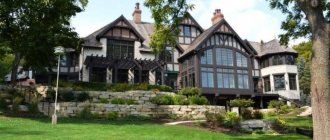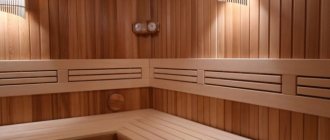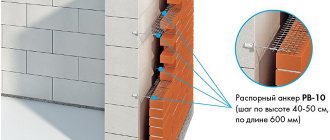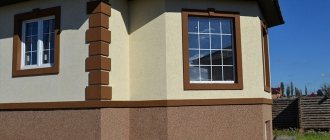Finishing
Decorating walls, floors and ceilings, choosing an interior idea - all this depends on the functional purpose of the basement.
Organization of space in the basement for wine storage
One of the main points is laying and establishing the necessary communications. This stage should be completed before finishing work begins. How can you transform your basement? In fact, a boring and unattractive basement room can easily be turned into a cozy and original studio, “painted” with unusual colors and unusual design solutions.
- Walls. To achieve an absolutely even and smooth effect, you can cover the walls with plasterboard with water-repellent properties. After this you can start plastering. With its help, you can easily create an interesting textured effect with your own hands, using rollers, sponges, brushes and anything your imagination suggests.
Textured plaster of basement walls
In addition to textured plastering, walls can be covered with wallpaper, decorated with decorative tiles or panels imitating wood. If the basement is going to be used as a warehouse or gym, a simple paint job can be done.
Painting the basement with white waterproof paint
- Floor. The most appropriate solution is floor tiles. You can install a “warm floor” system; for this, the concrete surface is covered with heat-insulating material, communications and wires are hidden under the screed. If desired, you can cover the floor with carpet or linoleum. Another option is wooden covering. In this case, it is necessary to give preference to breeds that are insensitive to possible increases in moisture.
- Basement lighting. The specificity of lighting is that, as a rule, there are no windows in such a room. Therefore, in order to create a comfortable atmosphere and avoid the “burrow effect”, it is necessary to achieve maximum illumination in the basement.
Lighting in the basement
There are several options:
- creating a lighting system using spotlights;
- placement of sconces, floor lamps and lamps;
- creating an adjustable light flow.
Spot lighting in the basement
As a result, we get a unique illusion of a window in which the sun shines brightly. This helps avoid the oppressive feeling of a closed space, creating an interesting play of light.
Light wall design
Arrangement of the basement of a private house is a complex process, where each stage affects the final result of the work. When choosing an interior design idea, you need to start from the purpose for which the room is intended. Light soft shades, bright color accents, original details, functional furniture, lack of dense partitions - all this can be used to create an ideal island of comfort, filled with light, space and lightness.
Remodeling the basement-cellar
Basement options
The basement is adapted to a variety of needs depending on the needs of the owners. In most homes, this room has impressive dimensions, which makes dreams of spacious areas for play, entertainment or work come true. Most often they create from the basement:
- Gym;
- Wine cellar with tasting area;
- A miniature bar for gatherings with friends;
- Swimming pool or sauna;
- Workshop for work;
- Laundry room for washing and ironing things. Relevant if the family is large;
- Billiard room combined with a darts and table tennis area;
- Games room;
- A greenhouse for growing vegetables or mushrooms. A kind of small household that doesn’t care about winter;
- A music studio with good sound insulation;
- Additional room for guests;
- Home cinema;
- Library and miniature reading room.
Place to rest
A place to relax in a spacious basement usually includes several functional areas:
- Reading corner;
- Bar counter for those who want to have a glass or two of wine;
- A platform for active games, and if dimensions allow, then even a miniature dance floor;
- Movie viewing area.
In small rooms you will have to limit yourself to one or two most important areas. The decoration of the basement room can be complemented by a cozy fireplace and firewood. They look especially colorful in rooms decorated in the now popular chalet style. The furnishings of the room have references to a holiday home, which is lost in the Alps, far from the bustling world. The chalet loves the abundance of wood, animal skins (imitation), brown-honey color scheme. Of course, the Alpine style is difficult to implement without the presence of panoramic windows with views of the mountains, but they are compensated for by false panels and an abundance of lamps of simple shapes. The fireplace is an integral part of the chalet. It is decorated with stonework or brick, and the fire doors are decorated with intricate ligature or ornaments, which are reflected in wall decoration and textiles. Please note that there should not be too many patterns; monotony prevails in the chalet.
Home cinema
In cottage houses, the basement is often equipped with a full-fledged mini-cinema. Films are viewed both on a modern large-format “plasma” of impressive dimensions, and on a white wall using a projector. The last option fits organically into the retro style. Seating can be arranged in several ways:
- Single chairs arranged in rows;
- Full-sized chairs with common armrests, like in real cinemas;
- Several sofas placed one after another.
The latter option allows, if necessary, to use the room for other recreation, therefore it is considered universal. A simple but sophisticated loft is suitable for a stylish cinema.
Library
A small basement can be converted into an individual room “for books”. The racks are installed solid: from the ceiling to the floor. A cozy place for reading or working is created in the corner. A soft sofa with a couple of pillows, a table and a couple of poufs for guests is enough. If you decide to place all your book treasures in the basement, then pay special attention to the fight against humidity. Over time, the paper may “bloom” in the bad sense of the word, and you risk losing your entire library.
Choosing a staircase
The finishing of the semi-basement begins with the stairs. The overall impression of the interior of the room depends on its appearance. The modern construction market offers a wide variety of staircase options, and if you couldn’t find the right one from the entire range, you can always make it to order. But before placing an order, let's understand the types of staircase structures.
Stairs are divided into three main types: marching, bolt and spiral.
Steel flight staircase.
The peculiarity of the flight of stairs is its bulkiness. Unfortunately, not all semi-basements can accommodate such a structure. However, such a staircase looks very beautiful and is an important piece of furniture. If the size of your semi-basement allows it to be placed, you will have to decorate not only the steps and railings, but also devote time to the areas between the flights, as well as the walls along them.
Bolt version of the staircase.
A bolt ladder can only be installed if there is a load-bearing wall (the ladder will be installed along it). The bolt staircase is a reliable and durable structure, which in skillful hands can become the main decoration of the room.
Spiral staircase.
The spiral staircase is characterized as the most inconvenient for descending and ascending, however, the undeniable advantage of such a staircase is its compactness. It does not take up much space and fits perfectly into a small room.
As for the material from which the stairs will be made, there are no restrictions. Wood, glass and metal are used in its production.
Installing a plinth on different types of foundations
The design and features of the base directly depend on the type of foundation. For example, a strip foundation requires a base that will carry a load-bearing function. For a columnar foundation, the plinth serves as protection from adverse environmental conditions.
How to make a lid for a cellar at home
Next, pure pleasant work begins - and when the floors were laid, the cellar lid was marked out. Or maybe a hatch to the cellar - I don’t know which is more correct.
Of course, in place of the hatch, the lag step was planned in advance. In this place it turned out to be a little wider than throughout the entire floor. But this is not critical, since the five board is also quite rigid, and the step turned out to be 90 cm everywhere, and in the area of the hatch it was around 1.3 meters:
Initially, the entire floor was covered, and then it was necessary to cut out a cover in the floor into the planned opening. To prevent any board from moving, it was decided to secure the boards surrounded by the lid with screws. The floor itself is pierced with 120 mm nails.
Great! When everything is secured, I mark the middle of the joists from the beginning to the end of the cellar lid. Using a ruler, we draw in the middle of the joists, on all four boards, first the covers and at the end. In simple words, we mark the lid, and at the moment when we cut it, each board must be motionless and, of course, not fall into the cellar). To prevent the boards from moving during sawing, and so that they were initially solid throughout the entire lid, I secured them with long bars on the outside of the lid, right on the floor. And when I sawed out the lid, I opened it as one piece, and carefully placed wooden jumpers inside the lid (an inverted letter Z in the photo above), and then simply unscrewed the temporary bars from the outside. You can see them from the other side of the lid, they are gray and thin (there is a long bar at the bottom)
I cut it out carefully with a chain saw. Calm petrol - cuts like clockwork
But with this type of gash, it is important to follow safety precautions to avoid kickback from the shredder. Be careful and keep a clear head!
The simplest cellar lid device
I decided to show the main points in the video to make it clear. In the future, gas stops will be mounted on the cover. But more on that later... Follow my story on HoHu
Home Basement Design Ideas
What can you turn your basement into? - you ask. Anything! If in the residential part of the house it is not possible to allocate space for your own hobbies or fun pastime, feel free to implement the project on the ground floor. We invite you to consider the latest ideas for rational use of space in the basement.
Utility room. Household appliances such as boilers and boilers rarely fit into the overall concept of a living space. So, why not move these devices, along with all utilities, to the basement? Here you will always have free access to them, and you don’t have to worry about their compatibility with the environment.
Laundry. Despite the attractive appearance of modern washing machines and dryers, it is not always possible to choose a model that would suit a bathroom or kitchen project. In view of this, the design of a basement in a private house can be “tailored” to laundry needs: connecting household appliances, designing a drying and ironing area.
Gym. The ground floor is a great place for sports. Instead of one exercise machine, usually hidden in the corner of the room or in a closet, it is possible to install a full-fledged set of exercise machines here. To equip the hall, it is necessary to lay a durable floor covering and seal the walls with soundproofing material. Thus, the noise from the operation of sports equipment will not disturb the household members relaxing in the main part of the house. It is advisable to make one of the walls mirrored to make the room seem more spacious.
Child's world. Parents often prohibit children from running and playing outdoor games in living rooms. But an active baby really needs space! Why not transform the interior of your home's basement into a children's area? Here the child will be able to play, play sports or frolic with friends without fear of disturbing adults.
Billiard room. This idea will appeal to the stronger half of humanity, and the fair half will not object to such a lounge area in the house
When decorating a room, it is recommended to pay special attention to lighting. It is necessary to organize uniform ceiling lighting above the billiard table; in the rest of the plinth you can get by with spotlights or sconces
In addition to the billiard table, the lounge area is often equipped with a seating area, a small table and a bar, creating comfortable conditions for friendly gatherings.
Home entertainment room. Spaciousness + distance from a residential area = an ideal place to create an amusement park. By setting up a cinema hall or gaming area with slot machines and consoles in the basement, you can immediately cut off loud sounds from the bedroom, living room or children's room. In addition to electronics, a soft corner and, if possible, a small refrigerator are placed in the plinth for convenience when watching movies.
Workshop, hobby room. The design of the basement of the house can be designed taking into account the hobbies of the household. Does playing drums (violin, piano, trumpet, etc.) prevent your loved ones from relaxing? No problem: create your own music studio in the basement – you’ll hardly be able to find a more isolated place! Of course, the basement can be turned into an art studio, modeling corner, repair shop, etc. Ideas for decorating a basement in a private home are as varied as hobbies.
https://interiordesigns.ru
What room should I make in the basement?
There are a lot of options for rational use of basement space. The choice depends on your preferences, home design and financial capabilities.
Rest room in the basement.
If you have a close-knit family and like to spend a lot of time together, dedicate the basement floor to a recreation area. You can install a home theater, complement it with a game console and other entertainment gadgets. A soft sofa and a few comfortable armchairs will not be a hindrance. Such a room does not need daylight, which is perfect for the specifics of the basement floor. Comfortable sofa, dim lights and your favorite movie!
The decoration of such a room should exclude too bright colors. This is why it is a relaxation area, so that the eyes and the body as a whole can rest, and too bright shades will lead to the opposite effect.
For lovers of paper books, you can equip a cozy library in the basement. Tall shelves filled with books, a comfortable ottoman, a not too bright lamp and an artificial fireplace will make this place your favorite. Together with the library, you can set up a personal office, and during breaks between work you can relax with a cup of hot tea and a new book.
Do you have cramped children's rooms and the kids have nowhere to enjoy games and throw out their energy? Set up a games room in the basement. Drawing tables, LEGO construction sets, mini-hockey and a railway can all be placed indoors.
Placement of the pool in the basement.
Do you like to swim, but never have enough time to visit the pool? So make a pool at home! The basement floor is perfect for this. And if you divide it into zones, then in addition to the pool you can equip a bathroom.
As you can see, there are many options, you just have to listen to your desires.
Capital construction
Excavation
- As a rule, the basement is laid at the design stage and erected during the construction of the house itself. However, installing a basement under part of the house is also possible during major renovations. True, in this case it will be necessary to dismantle almost all the finishing and seriously strengthen the foundation.
- We begin the work by determining the soil parameters. In order for construction to be successful, it is necessary to choose a dry place with deep groundwater.
- The construction of underground rooms or basement floors of houses in areas with water-soaked soil is also possible, but it requires mandatory drainage and strengthening of waterproofing contours.
Aligning the corners of the pit
In the selected place on the leveled area, we dig a pit. The easiest way to do this is to use an excavator and then level the walls with an entrenching tool.
Walling
The next stage of our work is the formation of a wall frame:
- At the bottom of the pit along the perimeter we dig a trench about 50 cm deep to lay the strip base. The width of the trench should allow the installation of wooden formwork, so approximately 10 cm should be added to the design dimensions of the foundation.
- We fill the trench with a sand cushion up to 20 cm thick, install the formwork and lay the reinforcement.
- We fill the formwork with concrete, forming a strip foundation. Complete drying of the foundation takes about 28 days.
Pouring a monolith with reinforcement
When the foundation is ready, we begin building the walls.
They can have very different designs:
- The most common option is where the basement walls are a continuation of the foundation. In this case, heavy reinforced concrete is used for their production, which is poured layer by layer (every 30-40 cm) into prefabricated formwork.
- If we have a crane at our disposal, then the walls can be made of concrete blocks. To connect them we use cement-sand mortar.
Block walls
Laying basement walls from brick, cinder block or foam concrete elements is also possible. However, it is advisable to implement this option in soils with a low tendency to heave.
After the walls are raised to the designed height, we lay a brick plinth on top. It will ensure uniform distribution of loads on the underground part, and will also provide increased thermal insulation properties.
We must waterproof the outside walls of the basement by coating them with hot bitumen mastic and covering them with roofing felt. Also at this stage it is possible to carry out insulation with synthetic board materials. Of course, the price of the project will increase, but we will reduce the likelihood of problems with the microclimate and condensation on the basement walls.
Laying the floor and forming the floors
Next, we begin to form the floor of our basement:
- We lay several layers of roofing material or a special waterproofing membrane on the gravel backfill.
- We fix a welded mesh of reinforcing rod on top of the roofing material.
- Fill the floor with concrete, forming a screed at least 15-20 cm thick.
Concreting the floor
When this work is completed, the floor can be formed. To do this, we use either reinforced concrete slabs or beams, on which we lay the flooring of the first floor. Don't forget to leave room for installing the stairs along which we will go down to the basement!
You need to move on to the next stage only after all construction work has been completed. After erecting the building and laying communications, you can begin equipping the underground space.
Storage conditions
It is no coincidence that for centuries wine was stored in basements: it was noticed that the drink does not tolerate the sun, but favors coolness. Wine connoisseurs know that proper storage is the key to maintaining quality, and special temperature and humidity conditions must be maintained in the room. The following conditions are considered optimal:
- Humidity fluctuations: within 70-75%, with 70% being the limiting value. Humidity is important for the preservation of wine corks; if it decreases, the corks will begin to dry out and become deformed, air will get into the bottles, and the taste of the contents will deteriorate.
- The room temperature should not exceed +12°C. However, for different wines there are narrower optimal storage conditions. So, for red wine you need +12-18°C, for white – +6-12°C. For a sparkling drink, +2-6°C is enough.
- To ensure optimal storage temperature, bottles are placed at different shelf levels. Containers with red wine are stored at the very top, where warm air accumulates. White wines are stored on the middle tier, sparkling wines are stored at the very bottom.
Modern design with lightweight shelvingSource architectureartdesigns.com
- Many drink connoisseurs claim that the temperature range can be expanded to +9-14°C without much harm to quality. True, such fluctuations should not be allowed to happen often.
- All types of wines are stored at an angle or in a horizontal position. This is done so that the contents envelop the plugs and they do not dry out.
- The lighting in the room should be artificial and always dim; no ultraviolet and therefore no windows.
- Vibration causes the sediment to stir, causing the wine to lose quality. Therefore, they try to locate vibration sources (for example, a washing machine) as far as possible from the room with bottles.
- You should not store fresh vegetables in the wine cellar. Cork easily absorbs foreign odors, which affects the quality of the contents. An exception can be made for fruits and home canning.
- Good ventilation is a must.
Illuminated niches in traditional styleSource hzcdn.com
Laundry room in the basement
In the basement next to the pantry, workshop or garage, space is often allocated for a laundry room and drying room (in winter), which is very convenient and saves the housewife’s time. The same room is used for bathing. Thus, a person returning from work can take a shower or bath without entering the main premises.
Laundry room in the basement
The necessary equipment of such a room should consist of a shower tray, sink, bathtub, gas or solid fuel water heater. A separate place must be allocated for the washing machine. It is necessary to make a drain in the floor to drain used water into the sewer. The floors in the laundry room are preferably made of ceramic tiles, which are very easy to use. The walls are also covered with ceramic tiles.
Laundry room in the basement
Important elements of the basement
It is not enough to simply build a basement, insulate it and install waterproofing. Care should also be taken to install other extremely important elements.
In this case we are talking about indoor ventilation equipment and stairs or hatches. Because only in this case will it be possible to stay in the basement.
The selection of these elements and their installation must be taken very seriously. Because the correctness of their installation determines how highly functional the room will be. In addition, if we are talking about arranging a residential space, then these elements are not just important, but basic.
Types and features of cellars
Do not confuse the cellar and the basement. Building a cellar at your dacha with your own hands can come down to simply digging a hole and minimally arranging it. The choice of the type of structure depends on many parameters, for example, on its intended purpose, on the climatic conditions of the region, financial capabilities, etc. Also, when choosing the type and materials for building a cellar in a country house with your own hands, you need to take into account its location.
It is easier to build a separate building than, for example, to build a cellar under the house, but this option will require more materials, and therefore more finance. Making storage under a residential building or outbuilding will be cheaper, but this option is limited in space.
Arranging a cellar will allow you to preserve preserved food and other products for a long time
One of the most popular options is an ice cellar. It copes well with the function of long-term storage of food even in the hot season and is especially in demand in the southern regions. It is quite difficult and expensive to build this type of cellar in a private house with your own hands, but the result is characterized by high performance characteristics, durability and reliability.
Another good option for this building is a storage unit with two sections. As a rule, this type is used when it is necessary to avoid mixing the odors of various vegetables and fruits that are simultaneously stored in the cellar. To build such a storage facility, you need less materials than for a glacier.
A separate type of cellar is a wine cellar. It is used for storing wine products and has its own design features and nuances that must be taken into account in order to properly build the cellar. As a rule, in such storage you can store not only wine, but also various preserves.
A wine cellar has design features that must be taken into account at the construction planning stage
Basement wall thickness
Walls are not just buildings. They play an important role. After all, in most cases the strength and durability of the foundation depends on them. Therefore, the process of their construction must be taken with great seriousness.
An important nuance is the correct choice of wall thickness. Because it depends on whether they will cope with the functions assigned to them or not.
Remember that long walls are more susceptible to lateral pressure. Their thickness largely depends on what material they were built from.
Preparatory work
Any construction work begins with the creation of a project. Determining the location of the cellar is an important point in the construction. You can build a cellar in a house on the ground floor, but if this is not provided, you need to consider other options with the construction of a structure on the site. For different schemes, you still need to track the depth of water underground in the area where the basement will be built (this is a mandatory step in preparation for work). This procedure is mandatory and official when constructing a residential building. If you already have a house, and the issue of a cellar is being decided, you can measure the point of passage of water underground in several ways yourself:
- It is enough to dig a hole more than 250 cm deep and simply observe the level of underground water flow over a few days.
- If somewhere in the neighboring areas there are wells or wells, then thanks to them, it is possible to measure the water level.
To determine the maximum point of water rise, it is necessary to carry out measuring work in early spring - during a flood or in the fall before the onset of frost. If the water level rises to 100 cm² of the soil surface, it is better not to start construction there, but to move the construction to a place that is ideally suited (water level 200-230 cm to the ground surface level).
There are chances to reduce the height of water rise thanks to a special design - drainage. It is installed in the underground of the future cellar
But there is a small nuance here - when using a drainage system, great attention must be paid to waterproofing the walls
You may be interested in: Options for redevelopment of a one-room apartment: the best ideas for expanding space and functional use
Description of species
The ground floor has several varieties, which differ from each other in the features of architectural design. There are 3 types of basement projects.
Speakers
The structure of the basement has a protruding appearance when looking at the walls of the building from the outside. Such a deliberate protrusion relative to the entire mass of the house requires the consumption of additional building materials, and therefore this option is considered the most expensive from an economic point of view. It is chosen when it is necessary to create increased thermal protection for walls located in the common base part of the building. Along the perimeter, such a protruding structure is equipped with a small slope with a gutter for drainage of rainwater, which protects the walls from getting wet.
Sinking
The structure of the ground floor is shifted inward by 8-10 cm relative to the overall mass of the building and its load-bearing walls. This approach allows you to significantly save the consumption of building materials, but nevertheless ensures the strengthening of the foundation of the house, its lower parts of the walls with a load-bearing load, and also serves as a waterproofing system that saves from rainwater that flows down the walls and gets into the ground.
Monolithic
The construction of the basement is carried out on the same plane as the load-bearing external walls of the house. In appearance, such a building looks the most natural and harmonious. Such a constructive solution makes it possible to strengthen the main walls of the building and additionally protects it from the destructive effects of moisture by installing waterproofing.
The basement floor of a monolithic building is made of bricks or blocks, as well as other building elements. This design is an excellent basis for implementing almost any design solutions in terms of exterior decoration.
All three types of design solutions have their own advantages and disadvantages, but, as practice shows, the monolithic version of the basement is most often used.
Plinth functions
You need to be prepared for the fact that installing a plinth will increase the cost of construction. But its presence will make the house more durable and reliable.
Let's look at exactly what functions the base performs:
- protection from moisture. Thanks to the plinth, the walls of the house are raised above ground level. Waterproofing is laid between the basement level and the wall of the house. Thus, the basement protects the house from spring floods and from excess water at any time of the year;
- thermal insulation. The presence of a basement helps reduce heat loss, which means a house with a basement will be more energy efficient;
- alignment. The plinth levels the transition between the foundation and the walls. With the help of the plinth part, a strictly horizontal base is created for laying walls, which facilitates construction and is especially necessary on uneven areas.
Particularly important practical problems are solved by the base of a wooden house. Thanks to a properly constructed plinth, the lower crowns of the walls will be reliably protected from moisture and rot.
Materials and principles of finishing
When starting finishing work, it is necessary to carry out high-quality insulation of the supply from water, and be sure to lay heat-insulating materials. Moisture penetrating inside leads to the destruction of materials and the occurrence of dampness, mold and fungal infections. When choosing materials for finishing, give preference to those whose moisture resistance indicators are quite high.
Decoration of the ceiling and walls is carried out only after cleaning and drying the room. If a mold stain is detected on the walls, it should be immediately removed and treated with fungicides. Only after this finishing is possible.
Walls
Before finishing the walls, you should carefully seal the seams, joints, irregularities and cracks on the surfaces. Then antifungal antiseptics are applied to prevent mold growth.
One of the most common options for finishing walls in the basement is sheathing with plasterboard impregnated with a moisture-repellent solution. It is mounted on a frame.
Work using plaster involves the use of cement mortars instead of chalk mortars, and for decorative finishing you can purchase mineral plaster or acrylic paint with increased water resistance.
Floor
Floors in the basement involve pouring a concrete screed, on which you can either make warm floors or a finished coating - parquet, laminate, timber, linoleum... when using natural wood materials, they try to use natural types that are more resistant to moisture. In particular, hardwoods can be recommended.
It is necessary to especially note the moment when installing heated floors - under the cables for heating the surface you need to lay a layer of material that retains heat. Otherwise, all the heat will go down into the concrete.
You can also hide wires, pipes and other wiring for life support systems under the floor. Although it is worth noting that if one of them fails, it will be necessary to dismantle the floor covering.
If the basement design involves the use of bright colors and light shades, then tiles can be used for greater decorative effect. Carpets should be preferred over carpeting, as a single layer of carpeting is not easy to dry and mold may develop.
Lighting
Basements have the dimmest lighting in the entire house. Due to the lack of window openings, the basement experiences a clear lack of natural light. This can easily be corrected by adding additional sources of artificial lighting.
They can be built into the ceiling as spotlights, or you can place floor lamps or sconces around the perimeter. It will be convenient to regulate the level of illumination by switching on all sources separately.
Modern design offers a “light wall” device - a device that imitates a large window. This helps relieve psychological discomfort when being in a confined space without windows.
Color design of the room
Everyone’s color perception is individual, so when choosing a basement interior, you should rely on your own perception of the color scheme. Of the general recommendations, we can only note that light colors will help create a more meditative environment, and bright accents in the design will add subtle positive notes.
Light walls and ceilings will add volume to the space, or vice versa - reduce the space to create intimate coziness, dividing the entire room into several zones with a finishing design.
When choosing the color scheme for your basement, pay attention to the color yellow. This choice is the optimal solution for rooms that lack natural light.
Warm shades of the sun will flood the room with light, giving a feeling of coziness and unprecedented comfort. Also, the yellow tint can energize.
Dark shades will beautifully create a visual accent on a certain piece of furniture. For example, you can highlight a fireplace in the interior. But don't use such shades as the basis of your design. At the level of perception, they will depress the psyche and create discomfort.
A few design tricks
There are a few more tricks used by designers in finishing basements:
To visually increase the height of the ceilings, you can use vertical stripes on wallpaper and when decorating walls. It is recommended to make the ceilings themselves stretch and multi-level.
If the ceiling is quite low, avoid bulky furniture. With medium height shelves or cabinets, there will be no feeling of enclosed space, and being in such a room will be pleasant.
Ceiling and lamps
The ceiling in any room plays a significant role. Proper finishing of the ceiling allows you to make rooms visually wider, disguise communications and even divide the room into zones.
Stretch ceiling with lamps.
Since quite a few UV rays enter the semi-basement room, it is necessary to take care of good artificial lighting in advance. To do this, you will need a lot of lamps, which are best distributed evenly across the ceiling. To give the ceiling a sophisticated look, you can use suspended structures and multi-level designs. Of course, if the height of the room allows it.
Mirrored or glossy ceilings will help make the room visually a little higher. This also allows for improved lighting levels. The reflective properties of the coating will create the effect of greater height. An excellent addition to such a ceiling would be “eyes” (the so-called spotlights that are mounted in the ceiling). They help not only to “raise” the ceiling, but also to make the room brighter.
Another option for ceiling lights.
Curved suspended ceiling, available for basements with high ceilings. Otherwise, you should give preference to a glass ceiling and place the lighting inside.











